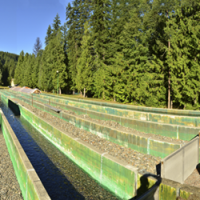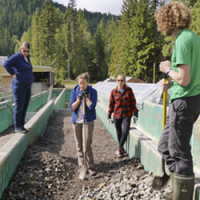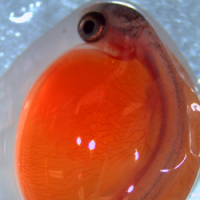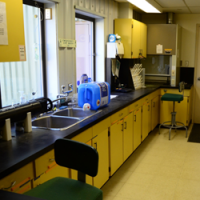QRRC Facilities and Equipment

The QRRC occupies the site of a former salmon hatchery, operated by the federal Department of Fisheries and Oceans (DFO) until 1995. Since the QRRC's establishment in 2002, the site has been developed to provide a range of facilities and equipment, with the aim of supporting a broad variety of environmental research and education.
We are usually able to offer meeting, classroom and office space, particularly through the main field season from May to October. Although the local area is not connected to cable or fibre networks, a satellite internet connection provides reasonable (wireless) bandwidth in all buildings. The buildings are equipped with a diesel generator and several portable generators, to ensure that power supplies are not interrupted during any major outage. We are also able to provide a range of in-house fabrication and repair capabilities.
We consider requests to rent equipment individually. In some instances we may be required to provide an operator, to comply with the conditions of the university’s insurance policies. There may be a cost associated with this, depending on the circumstances. Please contact us for more information.
For details of the accommodation available at the centre, please see the page describing the the residence.
Flumes
The QRRC’s set of six 30m ‘raceways’ or flumes is possibly the most distinctive of its facilities. These were originally built to provide a running-water environment for rearing salmon, fed from groundwater wells by two high-capacity pumps. They have recently been used again for this purpose to support research in fish biology (eg Lehnert 2016, 2017).
Additionally, a variety of substrates and structures may be installed in the beds of these artificial streams, providing a controlled experimental setting for a wide range of studies in fluvial sedimentology (eg Rex 2010, 2014) and civil engineering (eg Hirshfield 2015, Peng 2015).
(Top)


Hatchery Equipment
As well as the flumes, the former hatchery’s Capilano Troughs, indoor circular tanks and Heath Trays remain functional. In recent years, visiting scientists from the University of Windsor, the DFO, the Freshwater Fisheries Society of BC and the BC ministries of Environment and Forests Lands and Natural Resource Operations have made use of these facilities.
(Top)

Laboratory Facilities
The QRRC offers a well-equipped wet laboratory, with an E-Pure water purification system, drying and muffle ovens, and storage space in refrigerators / freezers. The adjacent incubation room also provides extensive space for preparation and temporary storage. The lab. is currently equipped with the following assets:
- Allegra X-30 centrifuge
- Malvern Mastersizer 3000
- Turner flow-through fluorometer
- Sartorius 4 and 5 digit balances
- Vaccuum-pump filtration system
- Leica dissecting microscope
Please note that we are obliged to charge bench fees of $20 per person-day for use of basic facilities. For visits involving laboratory use for more than five days, progressive reductions are applied on a sliding scale, so that the rate for a month or longer is $10 per person-day. Additional charges apply for use of specialist equipment and/or consumables.
(Top)

Weather Stations
The QRRC has hosted an automatic weather station (elevation 740 m) since 2006: two others were established in the same year on Browntop (2030 m) and Spanish Mountain (1510 m), and another was installed on the shore of Quesnel Lake in 2016. Two more are located at high elevations just to the east of the basin, near the Castle Creek Glacier (2105 m and 1803 m). These are all part of the Cariboo Alpine MesoNet, for which more information is provided on the data page.
(Top)

Field Equipment
The centre owns a variety of field equipment, and may be able to rent these to visiting researchers, depending on purpose and availability. These include -
- Eureka Manta2 sondes
- Sontek Acoustic Doppler Velocimeter (ADV)
- 'Low-tech' lake / river equipment, such as a Secchi Disc, Eckman Grab, Phillips Traps
- Field safety equipment (eg bear-spray)
- Field communications systems (short-range radios, satellite phone, Garmin-Delorme Inreach, GPS)
(Top)
Boats

In general, we crew these vessels in support of visiting researchers, rather than renting them out 'bareboat'.
Bookings / availability are shown on this Google calendar. Please contact us for pricing details.
(Top)
Vehicles
The centre has a 1-ton and ¾-ton 4x4 pick-up truck, which are used for fieldwork, local transport, and fetching supplies from the nearest major centre (Williams Lake). Depending on purpose and availability, it may be possible to arrange for visiting researchers to use one of these vehicles: again depending on detailed circumstances, we may be required to provide a driver, for which an appropriate cost will be charged. A Bobcat skid-steer is also used for a range of tasks around the site.
(Top)
